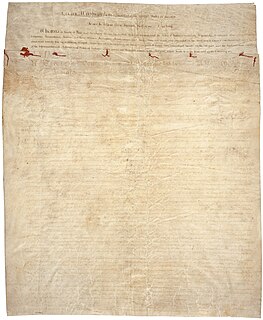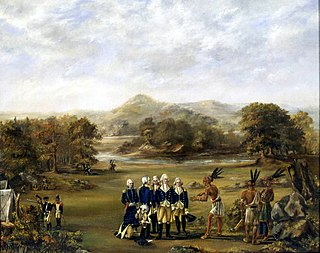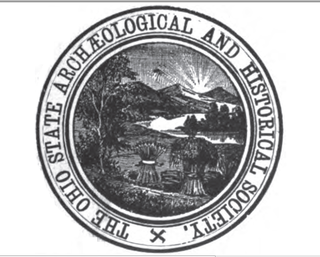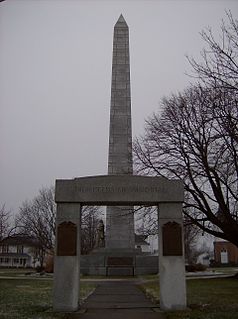
The Northwest Territory in the United States was formed after the American Revolutionary War, and was known formally as the Territory Northwest of the River Ohio. It was the initial post-colonial Territory of the United States and encompassed most of pre-war British colonial territory west of the Appalachian mountains north of the Ohio River. It included all the land west of Pennsylvania, northwest of the Ohio River and east of the Mississippi River below the Great Lakes. It spanned all or large parts of six eventual U.S. States. It was created as a Territory by the Northwest Ordinance July 13, 1787, reduced to Ohio, eastern Michigan and a sliver of southeastern Indiana with the formation of Indiana Territory July 4, 1800, and ceased to exist March 1, 1803, when the southeastern portion of the territory was admitted to the Union as the state of Ohio, and the remainder attached to Indiana Territory.

The Treaty of Greenville, formally titled Treaty with the Wyandots, etc., was a 1795 treaty between the United States and Indians of the Northwest Territory including the Wyandot and Delaware, which redefined the boundary between Indian lands and Whiteman's lands in the Northwest Territory.

The Maumee River is a river running from northeastern Indiana into northwestern Ohio and Lake Erie in the United States. It is formed at the confluence of the St. Joseph and St. Marys rivers, where Fort Wayne, Indiana, has developed, and meanders northeastwardly for 137 miles (220 km) through an agricultural region of glacial moraines before flowing into the Maumee Bay of Lake Erie. The city of Toledo is located at the mouth of the Maumee. The Maumee was designated an Ohio State Scenic River on July 18, 1974. The Maumee watershed is Ohio’s breadbasket; it is two-thirds farmland, mostly corn and soybeans. It is the largest watershed of any of the rivers feeding the Great Lakes, and supplies five percent of Lake Erie’s water.

The Wabash River is a 503-mile-long (810 km) river in Ohio and Indiana, United States, that flows from the headwaters near the middle of Ohio's western border northwest then southwest across northern Indiana turning south along the Illinois border where the southern portion forms the Indiana-Illinois border before flowing into the Ohio River. It is the largest northern tributary of the Ohio River. From the dam near Huntington, Indiana, to its terminus at the Ohio River, the Wabash flows freely for 411 miles (661 km). Its watershed drains most of Indiana. The Tippecanoe River, White River, Embarras River and Little Wabash River are major tributaries. The river's name comes from an Illini Indian word meaning "water over white stones".

The McCoys were a rock group formed in Union City, Indiana, in 1962. They are best known for their 1965 hit "Hang on Sloopy". Their name was changed from Rick and The Raiders to The McCoys, taken from the B side of The Ventures hit record Walk-Dont Run titled "The McCoy".

The Northwest Indian War (1785–1795), also known as the Ohio War, Little Turtle's War, and by other names, was a war between the United States and a confederation of numerous Native American tribes, with support from the British, for control of the Northwest Territory. It followed centuries of conflict over this territory, first among Native American tribes, and then with the added shifting alliances among the tribes and the European powers of France and Great Britain, and their colonials.

The Legion of the United States was a reorganization and extension of the Continental Army from 1792 to 1796 under the command of Major General Anthony Wayne composed of professionally trained soldiers, rather than state militias. The Legion was composed of four sub-legions each with its own infantry, cavalry, riflemen and artillery.

Justin Smith, known professionally as Just Blaze, is an American hip hop record producer and DJ. Born in Paterson, New Jersey, Blaze attended Rutgers University for three years before dropping out to pursue his musical career. His stage name was inspired by the character Blaze Fielding from the Streets of Rage video game series. Blaze is best known for producing Jay-Z songs on the albums The Blueprint, The Blueprint 2, and The Black Album. His production can also be found on Eminem's 2010 album Recovery. He appears in the video for the third single from Recovery entitled "No Love", which he produced. Blaze is also the CEO of Fort Knocks Entertainment. He has also composed soundtracks for video games, and was a character in NBA Street Vol. 2.

Gibson Township is one of the fourteen townships of Mercer County, Ohio, United States. The 2000 census found 1,869 people in the township, 997 of whom lived in the unincorporated portions of the township.

Recovery Township is one of the fourteen townships of Mercer County, Ohio, United States. The 2000 census found 1,550 people in the township, 1,149 of whom lived in the unincorporated portions of the township.
The Midwest Athletic Conference is an OHSAA athletic league located in west-central Ohio formed in 1972. It is one of the most competitive athletic conferences in the state of Ohio. Former Ohio State Running Back Chris "Beanie" Wells had stated, "The MAC should have its own division." after seeing 3 of the schools win state football championships in one year.. It maintains a rivalry with the Western Buckeye League which is composed of bigger schools.
The Siege of Fort Recovery, June 30, 1794, was a battle of the Northwest Indian War, fought at the present-day village of Fort Recovery, Ohio. As an American victory, it spelled the beginning of the end of the Confederation of Ohio Algonquians, under the control of the powerful Three Fires Confederation.
Fort Recovery High School is a public high school in the Fort Recovery School District, and is located in Fort Recovery, Ohio. Their nickname is the Indians. They are a member of the Midwest Athletic Conference.

State Route 119 is an east–west highway serving rural sections of west-central Ohio. It begins just west of Fort Recovery at the eastern terminus of Indiana State Road 26. It travels through Mercer, Auglaize, and Shelby counties to end at SR 65 in Jackson Township, Shelby County. The route is 42-mile-long (68 km) and serves the medium-size villages of Fort Recovery, St. Henry, Minster, and Anna.

St. Clair's Defeat also known as the Battle of the Wabash, the Battle of Wabash River or the Battle of a Thousand Slain, was a battle fought on November 4, 1791 in the Northwest Territory of the United States of America. The U.S. Army faced the Western Confederacy of Native Americans, as part of the Northwest Indian War. It was "the most decisive defeat in the history of the American military." It was the largest victory ever won by Native Americans.
Jim Zehringer is the Director of the Ohio Department of Natural Resources, who has served in the cabinet of Ohio Governor John Kasich, since 2011. He served in the Ohio House of Representatives from 2007 to 2011, and as a Mercer County Commissioner from 2002 to 2007. He is a farmer by trade.

Fort Jefferson was a fortification erected by soldiers of the United States Army in Oct. 1791 during the Northwest Indian War. Built to support a military campaign, it saw several years of active fighting. Today, the fort site is a historic site.

Ohio History Connection is a non-profit organization incorporated in 1885 as The Ohio State Archaeological and Historical Society "to promote a knowledge of archaeology and history, especially in Ohio". Until May 24, 2014, the organization was known as the Ohio Historical Society. Ohio History Connection exists to interpret, preserve, collect, and make available evidence of the past, and to provide leadership on furthering knowledge, understanding, and appreciation of the prehistory and history of Ohio and of the broader cultural and natural environments of which Ohio is a part. Its predecessor was founded by Brig. Gen. Roeliff Brinkerhoff in 1875. That society became dormant, and was revived at the urging of Governor George Hoadly in 1885.
















